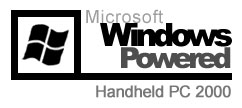The History of Microsoft Windows CE - Windows CE 3.0Windows CE 3 heralded a substantial change in direction for the Windows Mobile device development teams. Microsoft took the decision with the release of Windows CE 3. To create Embedded Operating System devices that would directly compete with the well long and established Palm OS based PDA's. This decision would see a ground up redevelopment of the User Interface of Windows CE Palm-Sized PC devices, which were now to be called Pocket PC's. The new UI took the much marketed 'Familiarity' out of the Windows CE range. The Taskbar and Start Menu were removed, replaced with similar, but less obvious components, and moved to a permanent home along the top of the display. The Familiar Windows UI was removed, instead opting for a flatter, more easily defined GUI. Windows CE 3.0 - Pocket PC 2000Microsoft Pocket PC (Pocket PC 2000 as it later became known) was released to the public in April 2000, and was the first platform release made against the new Windows CE 3.0 core which itself would not be released to developers for nearly two months. The Pocket PC program ran under the development code name Rapier, a type of sword Windows CE 3.0 - Handheld PC 2000While Microsoft were revolutionising their work on the Handheld PC's younger sister. The H/PC itself didn't quite undergo such a renaissance. The new Platform Builder provided the functionality of the Windows CE 3 Core, as well as incorporating the various new technologies that had emerged during and since the CE 2.11 Platform Builder had been released. Components such as Media Player, Terminal Server Client (RDP Client) appeared in the standard Clamshell device build options. However the remaining updates were far from as illustrious as that of the Pocket PC. A clear shift in Microsoft's development policy of Windows CE was starting to emerge. OEM's producing the Handheld PC were starting to dwindle. Microsoft central marketing almost exclusively Pocket PC 2000 orientated, and internal development inside Microsoft Mobile for applications and enhancements began to trail off by mid 2001. Windows CE 4 currently provides no light at the end of the tunnel for the Handheld PC Operating System, at least as far as Microsoft is concerned. While developers can build a H/PC platform on the device (See HPC:Factor HPC.net visual review). The key functionality that makes a Handheld PC a Personal Information Manager (PIM) and give it its distinctiveness (Pocket Office: Word, Excel, PowerPoint, Outlook, Access) are missing. By the beginning of 2002 there was no longer any department, or individual charged with work on the Handheld PC in any Microsoft subsidiary, anywhere in the world. Much can change in 7 years. Windows CE 3.0 - Pocket PC 2002Windows CE 3.0 Release History
TriviaContinuing from the Windows CE 2 era the Windows CE 3.0 Core codenames all relate to types of tree. Conversely, all Platform construction tools used codenames of tools used to cut down trees. Windows CE 3.0 was the final version of the operating system to use this naming schema. HPC2000's codename comes from renaissance scientist and artist Gallileo Galilei, who is credited with turning the eyes of mankind towards the stars, and discovering, amongst many other significant events, that the planet Jupiter (H/PC Professional) had celestial objects orbiting around it, brining an end to the concept that the Earth was the centre of the universe. SynchronisationThe Windows CE 3 generation of Host Synchronisation software; ActiveSync was developed under two code names. ActiveSync 3.0 (15th September 1999) and 3.1 were codename Xena ActiveSync 3.5, 3.6, 3.7, 3.7.1 and 3.8 were developed under the codename Medusa. For more on the lineage of ActiveSync 3.x click here. Handheld PC 2000 Screenshots | Handheld PC Device List
( Humble Beginnings | Windows CE 1 | Windows CE 2 | Windows CE 3 | Windows CE 4 | Windows CE 5 | Windows CE 6 ) |

